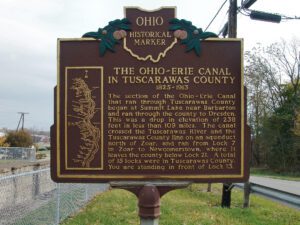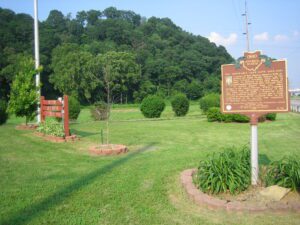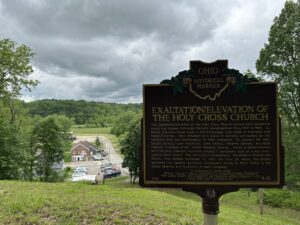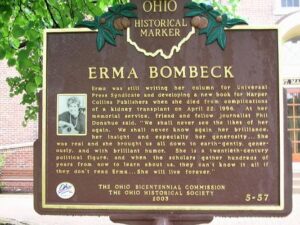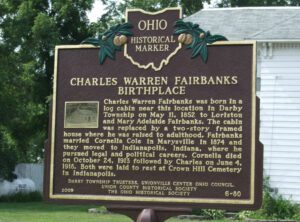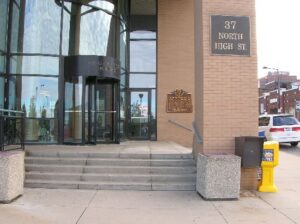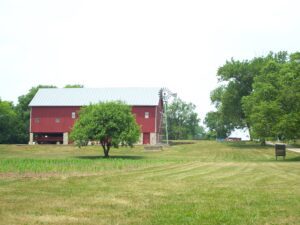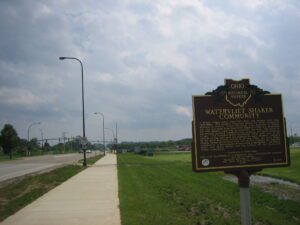, OH
Seeking an alternative transportation route to distant markets, many farmers and manufacturers in Ohio wanted to connect the Ohio River to Lake Erie with a canal. Beginning in Cleveland the Ohio-Erie Canal ran south, the length of the state, to Portsmouth. The canal was a total of 308 miles long, 40 feet wide at the surface, and 4 feet deep. The Ohio-Erie Canal opened for traffic along its entire length in 1832 and consequently effected great change. Population along the canal increased, and commercial, political, and industrial growth in Ohio boomed. Products grown and manufactured in this previously isolated region now had access to world markets. Profits for farmers and merchants increased, and the entire state economy was bolstered. With the rise of railroads in the 1860s, however, canals were destined to become obsolete because the railroad was a faster and more dependable means of transportation. The canal system ceased to operate altogether after a disastrous flood in 1913.
, OH
A native of New Boston, Vernal G. Riffe Jr. served the 92nd House District in the Ohio General Assembly from 1959 to 1994. As Speaker of the Ohio House of Representatives from 1974 through 1994, he served longer than any other speaker in the state’s history. Widely regarded as Ohio’s most influential legislator of the late 20th century, Riffe, a Democrat, built effective political alliances across party lines. A powerful advocate for southern Ohio, he was instrumental in the growth and expansion of Shawnee State University.
, OH
The Exaltation/Elevation of the Holy Cross Church served both Byzantine Greek and Russian Orthodox Catholic congregations from 1915 to 1967. As Slovak migrants found work in the Cambridge coal fields of Guernsey and Noble Counties, they dreamed of a place to worship surrounded by the religious rites and iconography of their homeland. On January 26, 1914, Daniel Varhola, John Fetkovich, John Demko, Stephen Varhola, and Mike Zeleznik (trustees of the “Greek Catholic Church, which is united forever with the Holy Catholic Apostolic Church”) purchased land on a hill overlooking Belle Valley. The two-sided cornerstone, inscribed in Russian and Slovak, was blessed November 15, 1915. For over 50 years, the church anchored the Eastern European immigrants living in Belle Valley to the ethnic identity and traditions of their homeland. (Continued on other side)
, OH
Erma Fiste was born in Dayton on February 21, 1927. While attending Patterson Cooperative High School, she worked as a copygirl for the Dayton Herald. After graduating from the University of Dayton in 1949, she married Bill Bombeck. She returned to the Dayton Journal-Herald as a reporter. Four years later she left the paper to raise three children, Betsy, Andy and Matt. She continued to write part-time from home. In 1965, Glenn Thompson of the Dayton Journal-Herald spotted her column in the Kettering-Oakwood Times and offered her a twice-a-week column. After three weeks he brought it to the attention of Newsday Syndicate. “At Wit’s End” grew to become nationally syndicated in over 900 newspapers. Erma wrote twelve books; nine made The New York Times Best Sellers List. In 1975 she joined the original cast of “Good Morning America” on ABC-TV and appeared regularly for eleven years.
, OH
Charles Warren Fairbanks was born in a log cabin near this location in Darby Township on May 11, 1852 to Loriston and Mary Adelaide Fairbanks. The cabin was replaced by a two-story framed house where he was raised to adulthood. Fairbanks married Cornelia Cole in Marysville in 1874 and they moved to Indianapolis, Indiana, where he pursued legal and political careers. Cornelia died on October 24, 1913 followed by Charles on June 4, 1918. Both were laid to rest at Crown Hill Cemetery in Indianapolis.
, OH
On this site on May 29, 1851, Sojourner Truth, a former slave, gave her world famous “And Ain’t I a Woman?” speech, recalling the hardships she had endured. Active in both the abolitionist and women’s rights movements, she electrified an audience of women and men who had come to the Universalist Stone Church for a two-day women’s rights convention.
, OH
This hamlet, located one mile southwest from here, was never platted, but was named after William Woods, president of the three-story brick Woodsdale paper mill constructed in 1867. Flanking the mill were the company office and store and several workers’ houses. Previous to this, the area flourished from the presence of two grist mills on the Great Miami River and from the Miami & Erie Canal. Additional enterprises such as a stone quarry, ice cutting company, and grain elevator operated here during the late 19th and early 20th centuries. Woodsdale was also known for the Woodsdale Island Amusement Park and the LC&D Railroad depot. The park, established on an island between the Miami & Erie Canal and the Great Miami River in 1891, was the site of picnics, political rallies, a large dance hall, and amusement rides–including a beautiful swan boat. The great flood of 1913 completely destroyed the park.
, OH
A Shaker village called Watervliet, Ohio, was located here from 1806-1900. The Shakers, originally called the United Society of Believers in Christ’s Second Appearing, were followers of Mother Ann Lee who came from Manchester, England in 1774 and established the first Shaker community in Watervliet, New York. The tenets of the religion included communal living, celibacy, and public confession of sins. The frenzied dance movements, which were part of the worship of their sect, gave the members the name “Shakers.” Attracted by the great Kentucky revivals in the late 1700s and early 1800s, Eastern Shaker missionaries came west to find converts and establish communities. A discontented Presbyterian congregation in the Beaver Creek area called Beulah was the nucleus for the Watervliet Shaker community. (continued on other side)


